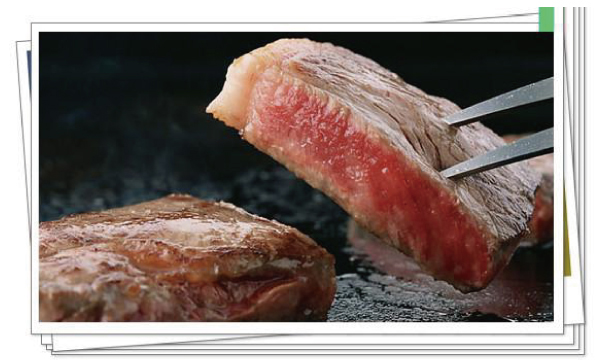Meat aging
Changes in meat after slaughter
After animals being slaughtered, the muscle will undergo a series of changes that are different from when alive, that converts muscle to meat becoming soft, juicy, and have a special taste and flavor, this is a process called meat aging.
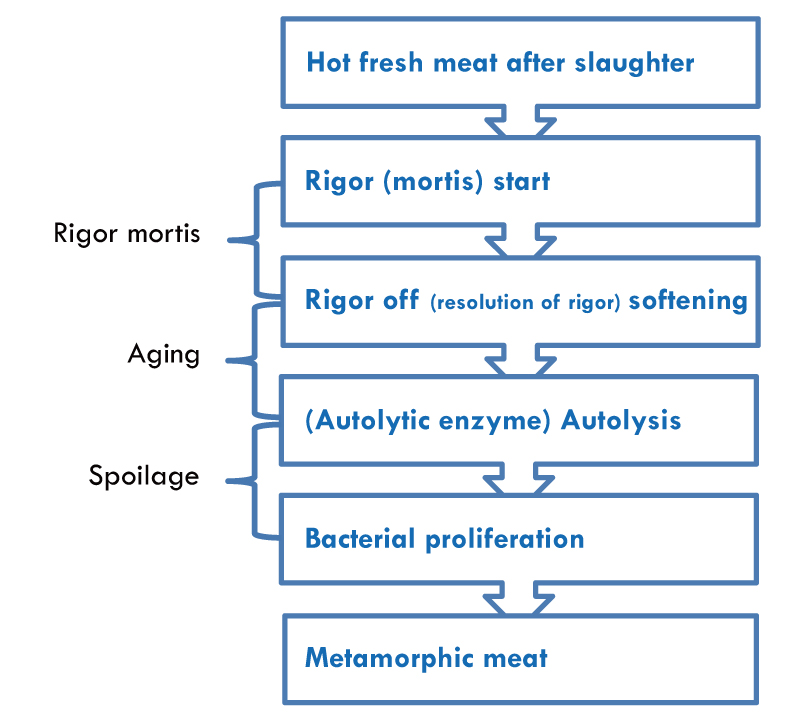
- Rigor mortis: Rigor mortis is happened between Rigor start and Rigor off (resolution of rigor) softening.
- Aging: Aging is the process between Rigor off (resolution of rigor) softening and (Autolytic enzyme) Autolysis.
- Spoilage: Spoilage is happened between (Autolytic enzyme) Autolysis and Bacterial proliferation.
The aging process can be divided to two stages, rigor mortis and rigor off (resolution of rigor)
What is rigor mortis?
- after animals being slaughtered, the carcass after a certain period of time, the stretchiness of meat is gradually disappeared, meat state changes from flaccid - tension - dull – to joints stiff that shows a rigid state, called rigor mortis.
- The reason why has rigor mortis? Myosin and Actin permanent cross-bridges causes rigor mortis.
-
The characteristics of meat in the rigor mortis are
- toughness
- not easily to cook meat well
- roughness
- higher drip loss
- flavor loss
- not have the characteristics of edible meat
- not suitable for meat processing and cooking
-
Rigor mortis mechanism
-
Meat ATP contents decreased sharply
- After animals being slaughtered, the ATP (adenosine triphosphate) contents are decreased rapidly. ATP levels decrease that leads to sarcoplasmic reticulum dysfunction, muscle cell body lost calcium pump effect out of control escape and not be recovered. A large number of ATP combined with troponin C, the final actin and myosin permanently combined to form actomyosin, causing muscle contraction, manifested as post mortem rigor after slaughter.
-
pH drop – reduce lactic acid
- After the animals are slaughtered, the glycogenolysis of the meat produces lactic acid, which is decomposed into phosphoric acid and lower the pH. The pH is declined until the glycolase activity disappears and stops at when reaching the final or ultimate pH value.
-
Cold Shortening (Contraction) and Thawing Rigor
-
What is cold shortening (contraction)?
- Before the pH of beef, lamb and turkey meat drops to 5.9 to 6.2 (that is, before the rigor state is completed), the muscle shrinks happen at when the temperature drops below 10 ° C and hardens in the subsequent cooking, this phenomenon is called cold shortening (contraction). Cattle, sheep, chickens in the low temperature conditions can also produce a sharp contraction, the red muscle has cold contraction phenomenon more than white muscle, especially in beef.
-
What is thawing rigor?
- Freeze muscles when the rigor is not completed, the muscles still contain high ATP, when thawed, due to muscle ATP is strong and rapid decomposition resulting stiff phenomenon, it is known as thawing rigor.
-
What is cold shortening (contraction)?
-
Meat ATP contents decreased sharply
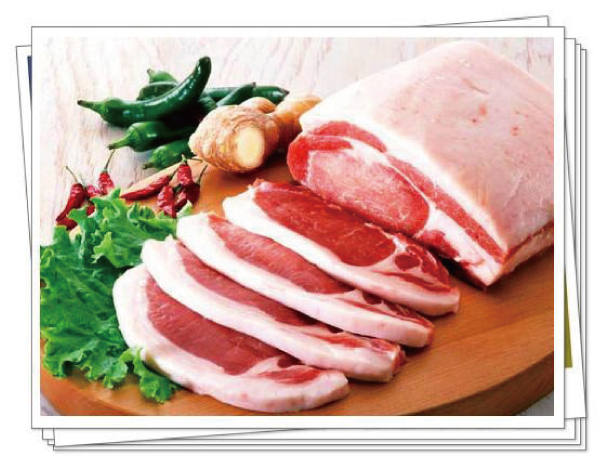
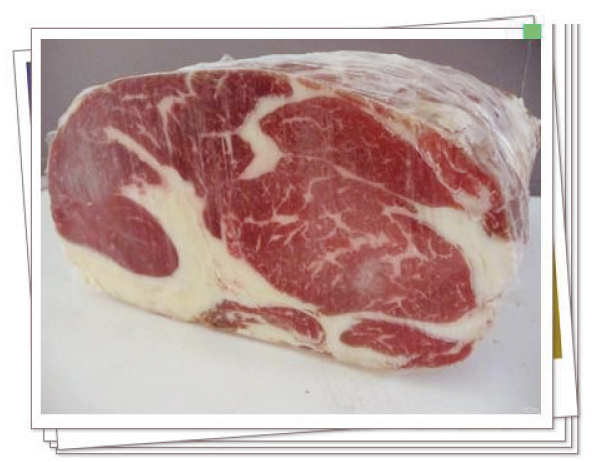
Effect of rigor mortis, times for onset and resolution of rigor off (resolution of rigor)
- Time for onset rigor mortis varies by animal species, pre-slaughter state, temperature, and slaughter methods.
- Rigor mortis onsets at 4.2 hours by bleeding death; 2 hours by electrical death; 1.2 hours by drug death.
- Rigor mortis onsets faster by no bleeding death, compared to bleeding death; and Rigor mortis onsets early, rapidly at high temperature, only shorter time needed for resolution of rigor, compared to that onsets late, slowly at low temperature that needs longer time for resolution of rigor. After achieved maximum rigor, meat begins to soften entered to autolysis stage, this is called rigor off (resolution of rigor).
- Carcass rigor mortis time

Rigor off (Resolution of rigor)
- After the muscle reaches the maximum rigor, a series of biochemical changes continue to occur, in which the rigor muscle water holdings rise, meat becomes softening, juicy with dedicate texture structure and good taste, this process known as rigor off (solution of rigor or autolysis).
-
Once meat is completed rigor off, meat becomes tenderness, juicy, good taste flavor and water retention.
-
rigor off (resolution of rigor) mechanism
-
Z- line disintegration
- After the animals were slaughtered, the sarcoplasmic reticulum function was destroyed, and the concentration of the sarcoplasmic reticulum was increased and the high concentration was prolonged in the Z-line, which made the Z-line protein degenerate and fragile, and the calcium-activated neutral protease Activation factor, CASF) is activated to promote the Z-line fracture.
-
Z- line disintegration
-
Protease effect
- Proteases effect, i.e., the effect of endopeptidase, cathepsin, lysosomal enzymes.
-
rigor off (resolution of rigor) mechanism
Meat aging methods
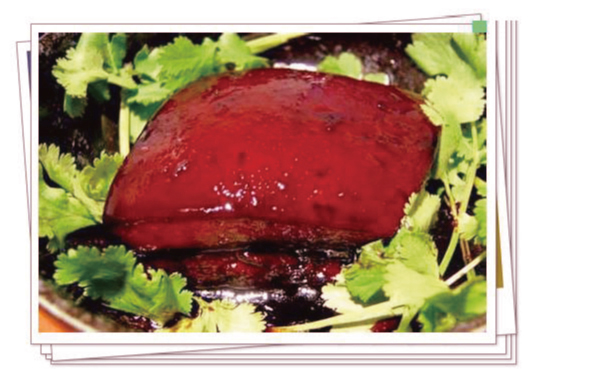
-
Aging in low temperature
-
Temperature :IFP(aging process above initial freezing point of food) ~ 4℃
Relative Humidity (RH):75~85% - Air velocity:0.15~0.5m/s
- Aging time: depends on animal species (for example, dry aging beef minimum needs 35 – 42 days)
-
Temperature :IFP(aging process above initial freezing point of food) ~ 4℃
-
Aging in high temperature
- temperature:10~15℃
- aging time:2~3days
- Microbes multiply on the surface of the meat, resulting in decreased meat quality that should not be recommended.
Ultrastructural changes in beef muscle fibers during natural aging
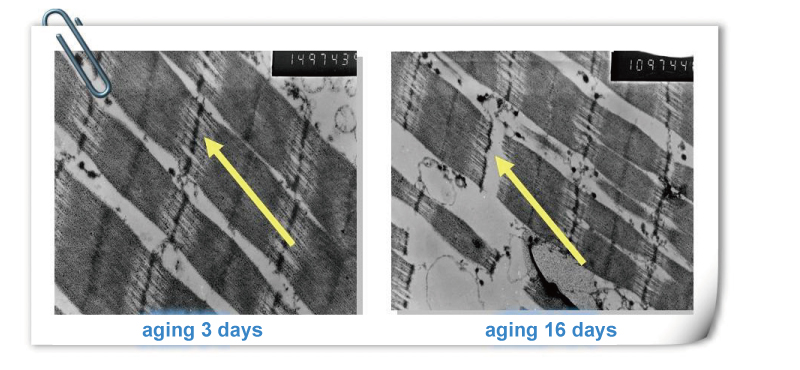
Chicken breast during aging process, the myofibrils are broken into small pieces
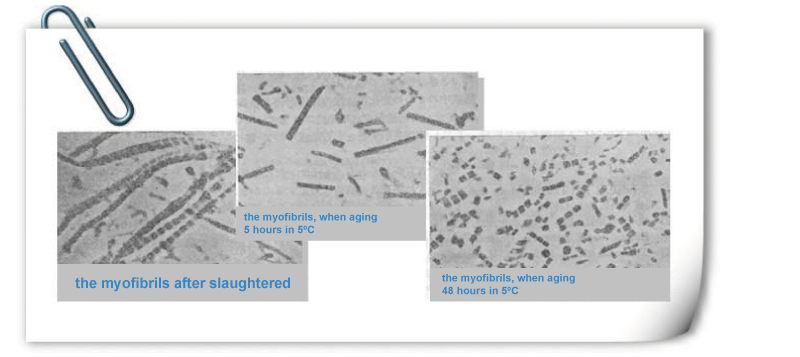
Beef during aging process, the connective tissue structure changes
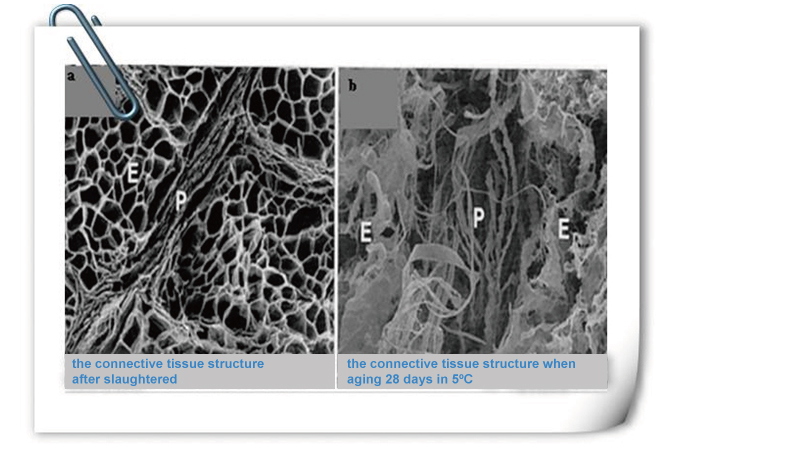
Changes in aging meat
-
Changes in pH
-
The pH of the meat is significantly changed during aging process.
After the animals are slaughtered, the pH of the meat is between 6 and 7 and declines about 1 hour later, and reached minimum 5.4 to 5.6 in rigor stage and then slowly increased with the prolongation of the preservation time.
-
The pH of the meat is significantly changed during aging process.
-
Changes in water retention
-
Meat water retention is recovered during aging. The recovery of water retention is related to the change in pH, and as the solution of rigor increases, the pH increases gradually - the water holding capacity of the meat increases. The protein breaks down into smaller units, causing an increase in muscle fiber osmotic pressure.
Water retention recovery can only be partially restored, that cannot be restored to the original state, due to muscle fibrin structure have been changes during aging.
-
Meat water retention is recovered during aging. The recovery of water retention is related to the change in pH, and as the solution of rigor increases, the pH increases gradually - the water holding capacity of the meat increases. The protein breaks down into smaller units, causing an increase in muscle fiber osmotic pressure.
-
Changes in tenderness
- The tenderness is at its lowest level after 2 days and nights, for example, the average tenderness of fresh meat is 74%, and after 6 days and nights, it will be re-increased, averaging up to 83% of fresh meat.
-
Change in flavor
-
During aging process, the free amino acid content of meat is increased as the protein is decomposed by cathepsin.
For example, tyrosine and phenylalanine are few in fresh meat, however, there are tyrosine, phenylalanine, threonine, tryptophan present in aging meat after meat aging process, and these amino acids have enhanced meat taste and aroma. Therefore, aging is used to improve meat flavor. During meat aging process, ATP decomposition produces hypoxanthine nucleotide (IMP), which functions a meat taste enhancer.
-
During aging process, the free amino acid content of meat is increased as the protein is decomposed by cathepsin.
